belt GMC SAVANA 1997 Owners Manual
[x] Cancel search | Manufacturer: GMC, Model Year: 1997, Model line: SAVANA, Model: GMC SAVANA 1997Pages: 388, PDF Size: 20.17 MB
Page 3 of 388

The 1997 GMC Savana Owner’s Manual
1-1
2- 1
3-1
4- 1
5-1
6-1
7- 1
8-1
9-1
Seats and Restraint Systems
This section tells you how to use your seats and safety belts properly. It also explains the “SIR’ system.
Features and Controls
This section explains how to start and operate your vehicle.
Comfort Controls and Audio Systems
This section tells you how to adjust the ventilation and comfort controls and how to operate your audio system.
Your Driving and the Road
Here you’ll find helpful information and tips about the road and how to drive under different conditions.
Problems on the Road
This section tells what to do if you have a problem while driving, such as a flat tire or overheated engine, etc.
Service and Appearance Care
Here the manual tells you how to keep your vehicle running properly and looking good.
Maintenance Schedule
This section tells you when to perform vehicle maintenance and what fluids and lubricants to use.
Customer Assistance Information
This section tells you how to contact GMC for assistance and how to get service and owner publications.
It also gives you information on “Reporting Safety Defects” on page
8- 10.
Index
Here’s an alphabetical listing of almost every subject in this manual. You can use it to quickly find
something you want to read.
i
ProCarManuals.com
Page 9 of 388

Section 1 Seats and Restraint Systems
Here you’ll find information about the seats in your vehicle\
and how to use your safety belts properly. You can also
learn about some things you should
not do with air bags and safety belts.
1-2
1-10
1-14
1-15
1-15 1-24
1-25
1-25 Seats and Seat Controls
Safety Belts: They’re for Everyone
Here Are Questions
Many People Ask
About Safety Belts
-- and the Answers
How to Wear Safety Belts Properly
Driver Position
Safety Belt Use During Pregnancy
Right Front Passenger Position Supplemental Inflatable
Restraint (SIR) System
1-32
1-35
1-37 1-40
1-49
1-52 1-52
1-52 Rear Seat Passengers
Center Passenger Position
Children
Child Restraints
Larger Children Safety Belt Extender
Checking Your Restraint Systems
Replacing Restraint System Parts
After
a Crash
1-1
ProCarManuals.com
Page 12 of 388
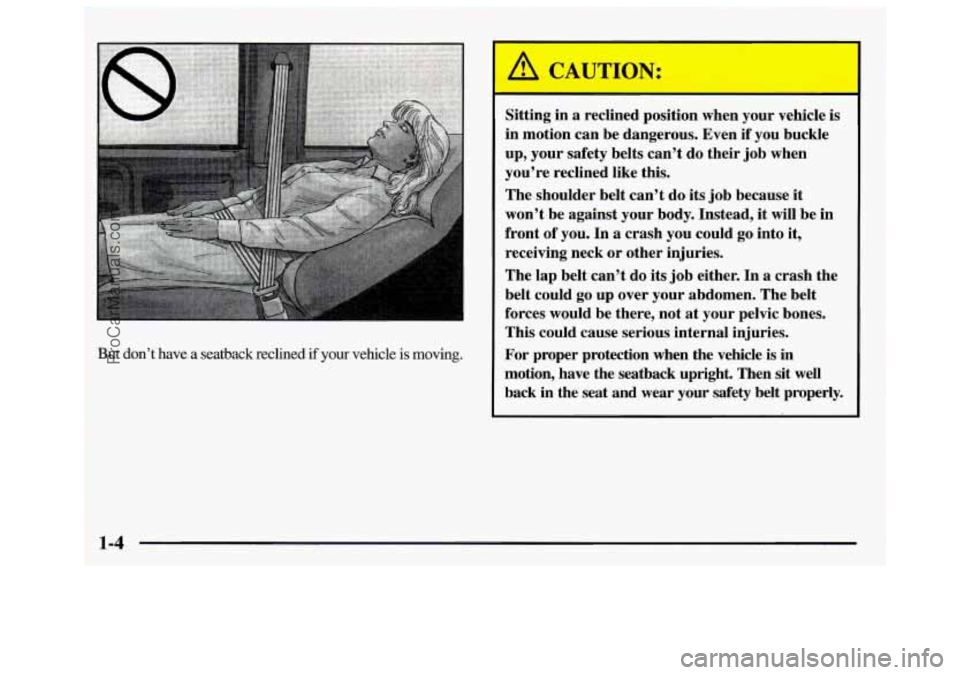
But don’t have a seatback reclined if your vehicle is moving.
~___
Sitting in a reclined position when your vehicle is
in motion can be dangerous. Even
if you buckle
up, your safety belts can’t do their job when
you’re reclined like this.
The shoulder belt can’t do its job because
it
won’t be against your body. Instead, it will be in
front of you. In a crash you could go into it,
receiving neck or other injuries.
The lap belt can’t do its job either. In
a crash the
belt could go up over your abdomen. The belt
forces would be there, not at your pelvic bones.
This could cause serious internal injuries.
For proper protection when the vehicle is in
motion, have the seatback upright. Then sit well
back
in the seat and wear your safety belt properly.
1-4
ProCarManuals.com
Page 13 of 388
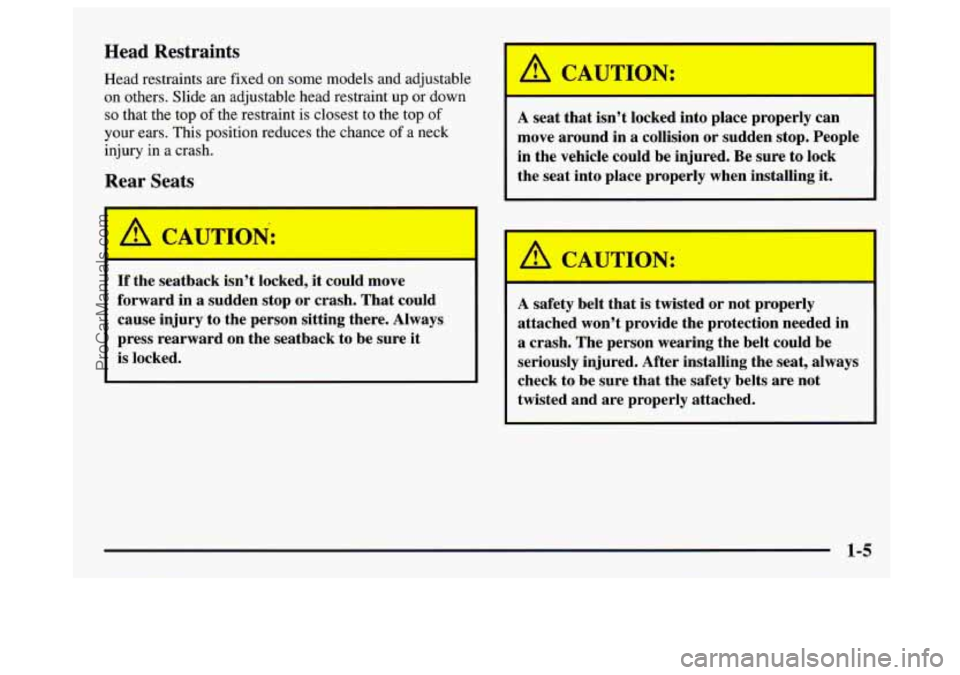
Head Restraints
Head restraints are fixed on some models and adjustable
on others. Slide an adjustable head restraint up or down
so that the top of the restraint is closest to the top of
your ears. This position reduces the chance of a neck
injury
in a crash.
Rear Seats
A CAUTION’:
-
If the seatback isn’t locked, it could move
forward in a sudden stop or crash. That could
cause injury to the person sitting there. Always
press rearward on the seatback to be sure it
is locked.
CI 7TION:
A seat that isn’t locked into place properly can
move around in
a collision or sudden stop. People
in the vehicle could be injured. Be sure to lock
the seat into place properly when installing it.
A CAUTION:
I
~- -
A safety belt that is twisted or not properly
attached won’t provide the protection needed in
a crash. The person wearing the belt could be
seriously injured. After installing the
seat, always
check to be sure that the safety belts are not
twisted and are properly attached.
1-5
ProCarManuals.com
Page 14 of 388

Removing the Rear Seat
2. Lift the carpedmat flap at the inboard side of the seat
base
in the rear.
1. Disconnect the quick release latch plates for the lap
shoulder belts on the bench seat
to be removed. To
do this, press the tip of a key into the release hole
of the safety belt buckle while pulling up on the
safety belt.
1-6
ProCarManuals.com
Page 16 of 388
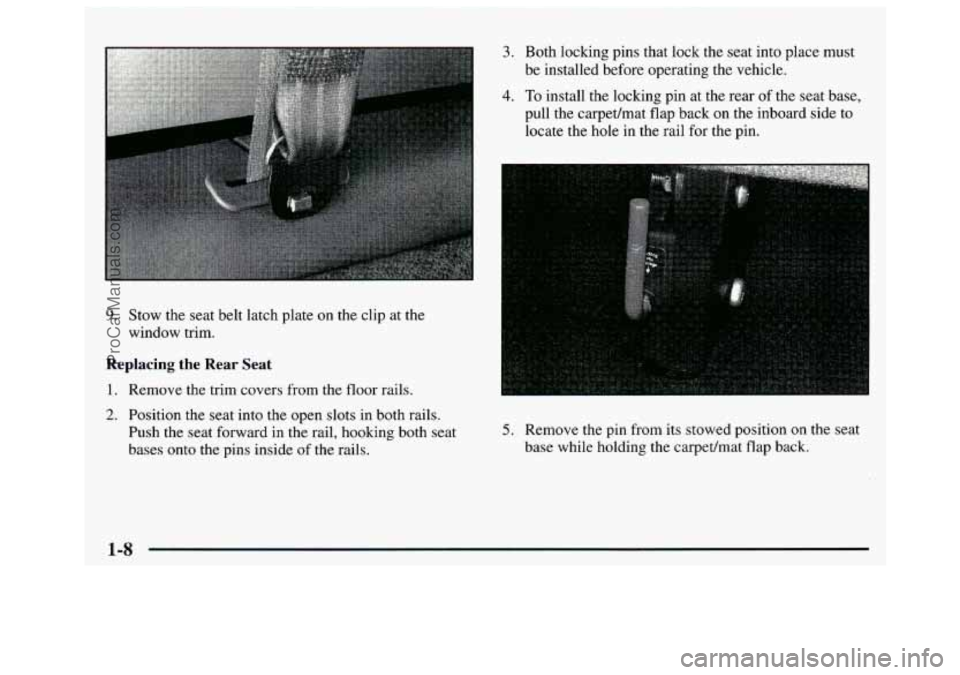
I
9. Stow the seat belt latch plate on the clip at the
window trim.
Replacing the Rear Seat
1. Remove the trim covers from the floor rails.
2. Position the seat into the open slots in both rails.
Push the seat forward in the rail, hooking both seat
bases onto the pins inside of
the rails.
3. Both locking pins that lock the seat into place must
be installed before operating the vehicle.
4. To install the locking pin at the rear of the seat base,
pull the carpedmat flap back
on the inboard side to
locate the hole in the rail for the pin.
5. Remove the pin from its stowed position on the seat
base while holding the carpet/mat flap back.
1-8
ProCarManuals.com
Page 17 of 388
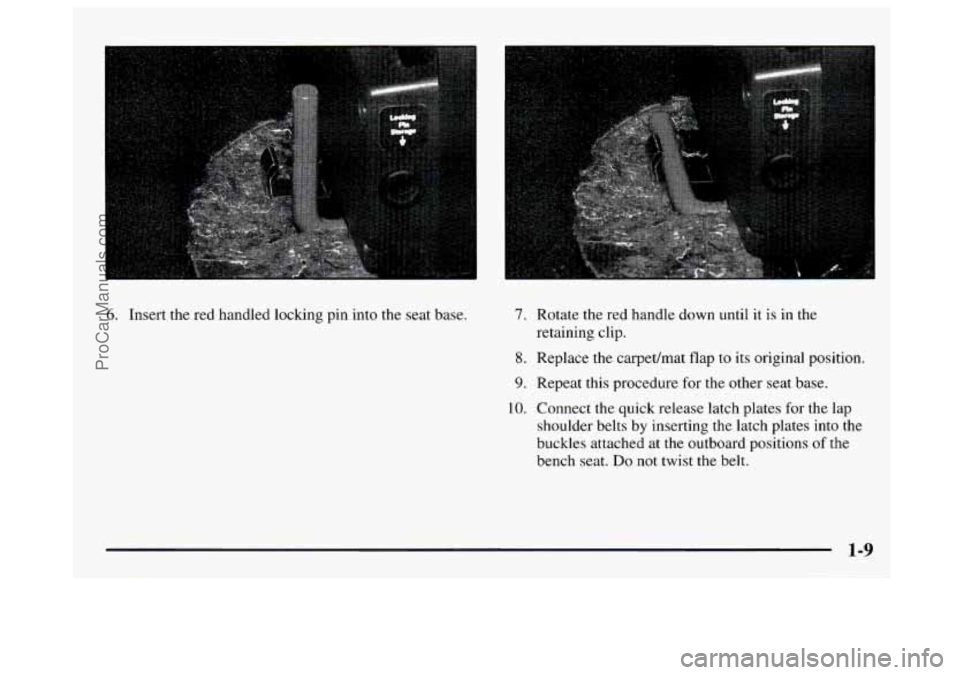
6. Insert the red handled locking pin into the seat base. 7. Rotate the red handle down until it is in the
retaining clip.
8. Replace the carpet/mat flap to its original position.
9. Repeat this procedure for the other seat base.
10. Connect the quick release latch plates for the lap
shoulder belts by inserting the latch plates into the
buckles attached at the outboard positions
of the
bench seat.
Do not twist the belt.
1-9
ProCarManuals.com
Page 18 of 388
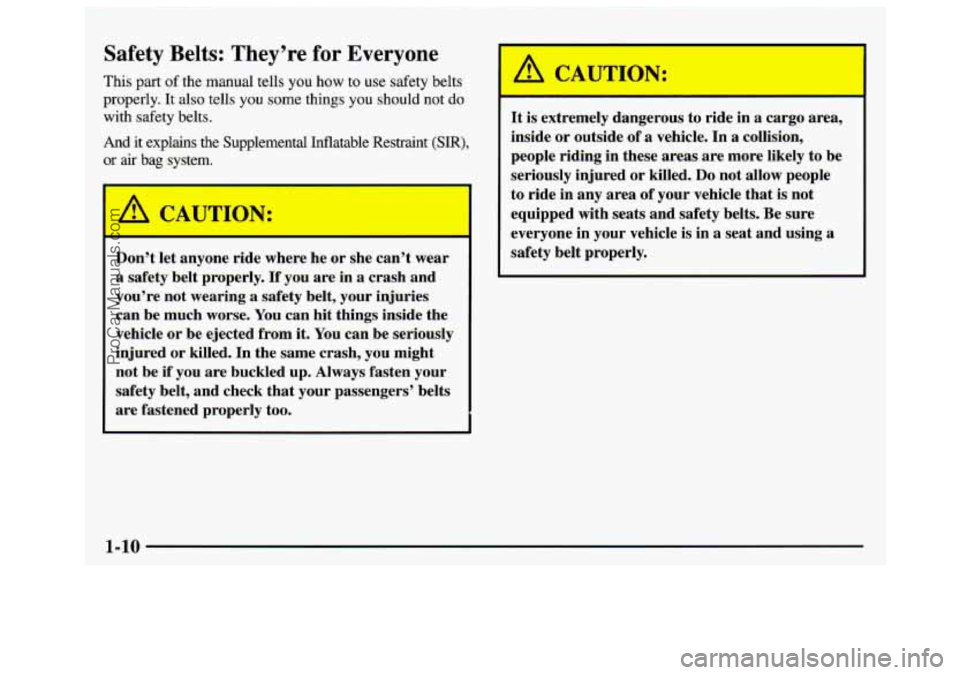
Safety Belts: They’re for Everyone
This part of the manual tells you how to use safety belts
properly. It also tells
you some things you should not do
with safety belts.
And it explains
the Supplemental Inflatable Restraint (SIR),
or air bag system.
A CAUTION:
Don’t let anyone ride where he or she can’t wear
a safety belt properly. If you are in a crash and
you’re not wearing a safety belt, your injuries
can be much worse.
You can hit things inside the
vehicle or be ejected from it.
You can be seriously
injured or killed. In the same crash, you might
not be
if you are buckled up. Always fasten your
safety belt, and check that your passengers’ belts
are fastened properly too.
I
A CAUTION:
It is extremely dangerous to ride in a ca -0 area,
inside or outside of a vehicle. In a collision,
people riding in these areas are more likely
to be
seriously injured
or killed. Do not allow people
to ride in any area of your vehicle that is not
equipped with seats and safety belts.
Be sure
everyone in your vehicle is in a seat and using
a
safety belt properly.
1-10
ProCarManuals.com
Page 19 of 388
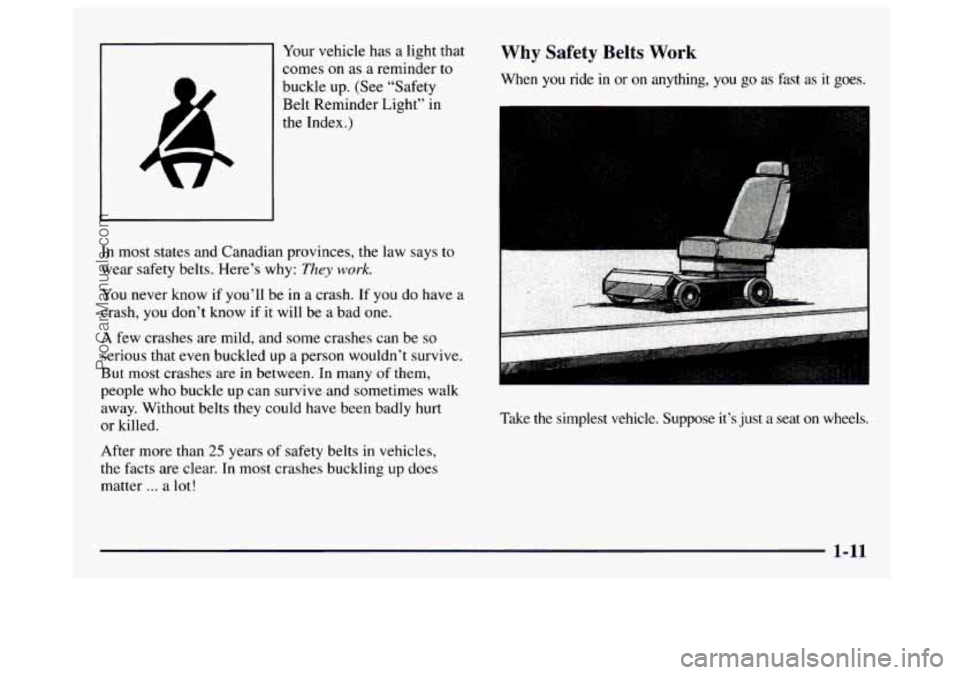
Your vehicle has a light that
comes
on as a reminder to
buckle up. (See “Safety
Belt Reminder Light” in
the Index.)
In most states and Canadian provinces, the law says
to
wear safety belts. Here’s why: They work.
You never know if you’ll be in a crash. If you do have a
crash, you don’t know if it will be a bad one.
A few crashes are mild, and some crashes can be so
serious that even buckled up a person wouldn’t survive.
But most crashes
are in between. In many of them,
people who buckle up can survive and sometimes walk
away. Without belts they could have been badly
hurt
or killed.
After more than
25 years of safety belts in vehicles,
the facts are clear.
In most crashes buckling up does
matter
... a lot!
Why Safety Belts Work
When you ride in or on anything, you go as fast as it goes.
~
~~
Take the simplest vehicle. Suppose it’s just a seat on wheels.
1-11
ProCarManuals.com
Page 22 of 388
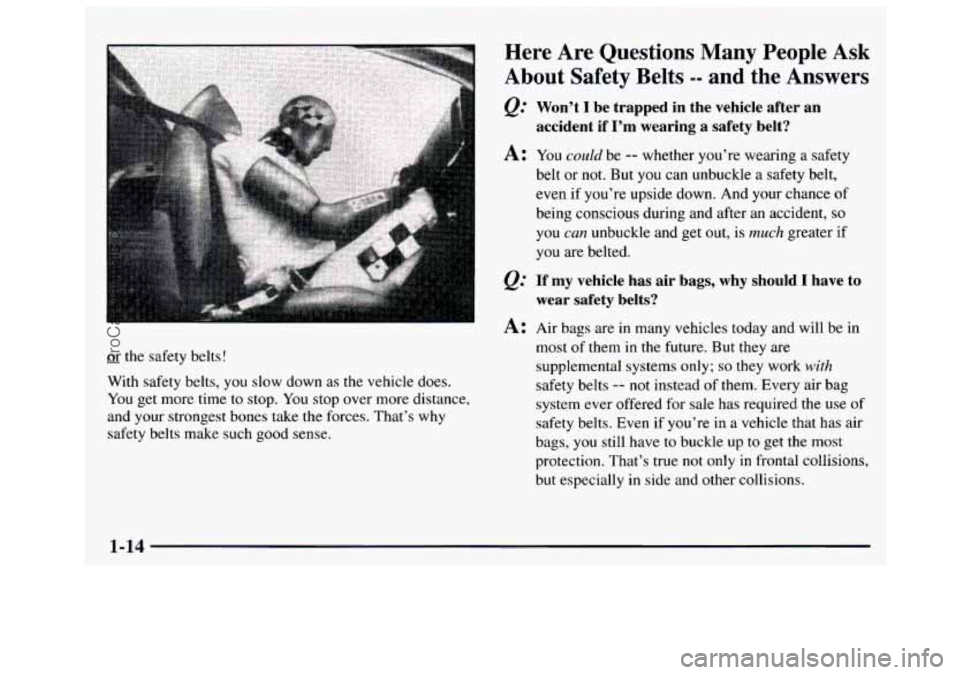
I ..
or the safety belts!
With safety belts, you slow down as
the vehicle does.
You get more
time to stop. You stop over more distance,
and your strongest bones take the forces. That’s
why
safety belts make such good sense.
Here Are Questions Many People Ask
About Safety Belts -- and the Answers
Q: Won’t I be trapped in the vehicle after an
accident if I’m wearing a safety belt?
A: You could be -- whether you’re wearing a safety
belt or not.
But you can unbuckle a safety belt,
even if you’re upside down. And your chance
of
being conscious during and after an accident, so
you can unbuckle and get out, is much greater if
you are belted.
If my vehicle has air bags, why should I have to
wear safety belts?
A: Air bags are in many vehicles today and will be in
most of them in the future. But they are
supplemental systems only;
so they work with
safety belts -- not instead of them. Every air bag
system ever offered for sale has required the use of
safety belts. Even if you’re
in a vehicle that has air
bags, you still have to buckle up to get the
most
protection. That’s true not only in frontal collisions,
but especially in side and other collisions.
1-14
ProCarManuals.com